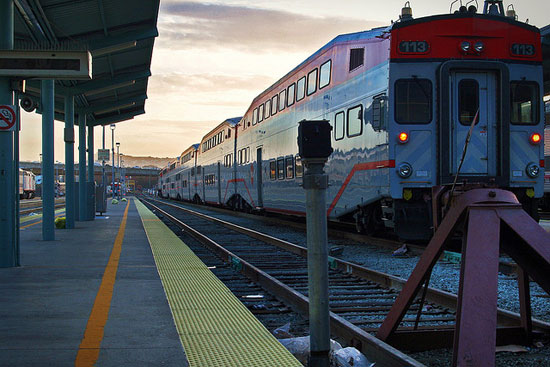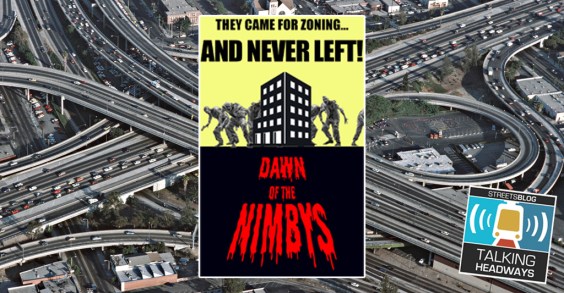
There was a groundswell of support to save Caltrain at the Friends of Caltrain Summit Saturday, an event that brought a standing room only crowd to the auditorium at the SamTrans building in San Carlos. Friends of Caltrain is a grassroots effort attempting to stop Caltrain from cutting evening, midday, weekend, and Gilroy service.
The summit was an early step in a long process to keep Caltrain financially viable. Long-term funding for the railroad may take years to secure, but in the short term, Friends of Caltrain is urging people to take action by writing their representatives to prevent drastic cuts in Caltrain service.
Yoriko Kishomoto, former mayor of Palo Alto, kicked off the summit by outlining the dire financial state of Caltrain. Caltrain is facing a $30 million budget deficit for fiscal year 2012. To close that gap, Caltrain will need to reduce its service from 86 trains per day to 48 trains per day, shrinking the operation to commute periods only. Even with only 48 weekday trains, Caltrain still projects a budget deficit of $4.7 million, but the agency thinks it can find that money somehow.
The Friends of Caltrain organizers emphasized that service cuts are not a done deal. Time is very short, but the attention that is being brought to bear on the issue may have an impact on monies that could be used to shore up the railroad, at least in the short term.
Longer term, the overriding consensus at the meeting centered on the importance of a dedicated funding source for Caltrain. Caltrain, the only transit agency in the Bay Area without a steady funding source, relies on funding from transit agencies in the three counties Caltrain serves. These partner transit agencies are facing difficult financial times themselves, and have cut their support for Caltrain.
Representative Jackie Speier (D-San Mateo), was a keynote speaker, and she expressed her support for finding ways to keep the commuter rail line afloat, including the possibility of implementing new taxes to raise money for Caltrain. She emphasized that easy answers don’t exist, but she said, “We owe it to our kids to preserve and grow this transit system.”
There were two panel discussions to ready participants the main focus of the event, breakout sessions to collect ideas from the community. Panelists told the history of Caltrain and it continues to be a vital transportation system for Bay Area commerce and communities.
Chuck Harvey, executive director of Caltrain operations, explained that Caltrain operates more efficiently that many peer transit agencies. All public transit is subsidized, but Caltrain farebox recovery is 47 percent, better than all other Bay Area transit agencies except BART.
Generally speaking, those who commute by car may not understand the benefits they receive from Caltrain. If Caltrain were to stop operating, there would be an additional 300 million annual passenger miles on Bay Area roads, according to Harvey. Congestion on highways 101 and 280 would noticeably increase.
Terry Nagel, mayor of Burlingame, said that “Washington DC is laughing at us, because all the cities do is bicker.” She said we need to consolidate our political power, because otherwise it will be ‘divide and conquer’.
San Francisco Supervisor Sean Elsbernd, the chair of the Peninsula Corridor Joint Powers Board that runs Caltrain, said he will be “Caltrain’s biggest cheerleader in San Francisco.” He said that many San Franciscans don’t care about Caltrain, but they don’t realize how much more traffic congestion and pressure on parking spaces there would be in San Francisco without Caltrain.
A member of the audience expressed concern that cutting Caltrain service would have a negative impact on transit providers up and down the Peninsula, because Caltrain delivers many passengers to Muni, SamTrans, and VTA buses. Elsbernd agreed that the demise of Caltrain could be the start of a death spiral for other transit operators as well.
Rebecca Long, senior analyst at the Metropolitan Transportation Commission (MTC), said the MTC has the authority to place on the ballot a gas tax up to 10 cents per gallon, but it would need a two-thirds majority to pass. She noted that should such a measure be approved, the funds would be distributed to various things, not just Caltrain.
A presentation from the BIKES ONboard team of the San Francisco Bicycle Coalition showed that Caltrain could earn $1 million more in ticket revenue annually by replacing empty seats with bike racks to meet demand.
For the afternoon session, the attendees split into breakout groups to brainstorm ideas to help save the railroad.
The finance breakout group came up with short-term and long-term solutions. Short-term solutions included temporarily redirecting money from the Dumbarton rail project to Caltrain, charging more for parking, and adding onboard bike capacity to increase ridership and ticket revenue.
The proposed long-term financial solutions included levying a gas tax, and increasing ridership through service improvements such as WiFi onboard trains and coordinating schedules with other transit agencies to improve connectivity.
The messaging break out group developed myriad messages that emphasize the value of Caltrain to the Bay Area. Caltrain saves money overall for the public, because driving is heavily subsidized. The group also noted that riding Caltrain is less stressful than driving and is a more environmentally friendly way to commute.
A third breakout group focused on how to expand outreach to let people know about Caltrain’s impending financial collapse. The group suggested targeting outreach to chambers of commerce and developers of transit-oriented development, as well as organizations for the elderly, current Caltrain commuters, students, and the media.
A fourth group considered long-term vision for Caltrain. They proposed to connect transit region-wide, as well as to control costs and increase ridership to raise revenue. Electrification of Caltrain is in the works, but it was suggested that hybrid diesel multi-units might be an interim option to avoid the expense of overhead wires.
“The turnout [for the summit] shows that people in the Caltrain corridor are committed to protecting this important resource. The vision of walkable, bikeable, sustainable communities is only possible if we keep and improve transit," said Adina Levin, one of the organizers of the summit.
The Peninsula Corridor Joint Powers Board will hold its monthly meeting at 10am, Thursday, February 3 at 1250 San Carlos Avenue, San Carlos.





